The Ranger from Christensen Arms surprised me as it offers an awful lot of specification for what seems a very competitive price. It is fundamentally a lightweight hunting rifle, and from the second I opened the box the delighted look that appeared on my face has never faded.
The Ranger has an 18" tensioned carbon fibre barrel. Being a rimfire, it has nothing like the powder and friction-generated heat that needs to be shed from a centrefire barrel. Relatively speaking, a rimfire gets an easy life and is less of a concern when using a still evolving material/manufacturing concept.
There is a ½"x28 TPI thread at the muzzle for moderator or brake (if you really want one on a rimfire). The visible steel is just the tip of the 18.1mm/0.858" diameter barrel. The review rifle was a .22 LR, which is likely to be the most popular version, but the Ranger is also available in .17 HMR and .22 WMR. This one has a 1 in 16" twist rate for the soft lead slugs that are common for sporting rifles.
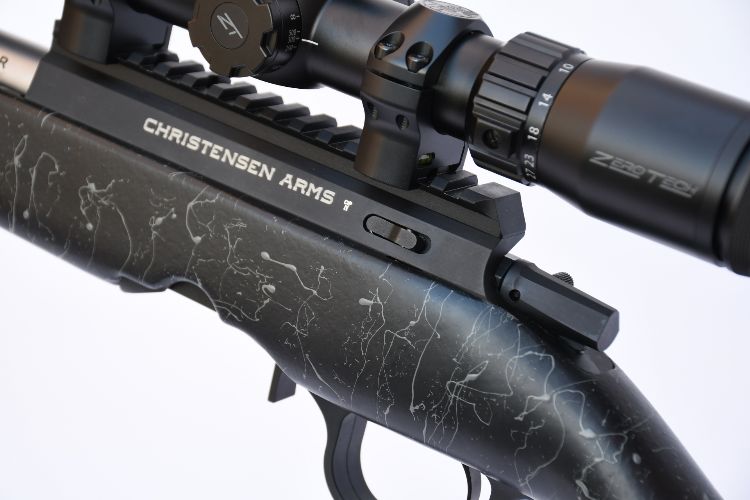 Stainless steel emerges from the carbon fibre jacket where the reinforce becomes the tenon, entering at the front of the receiver. There is a zero inclination Picatinny rail running the full length of the action, allowing space for scope mounting. This rail is bolted to the aluminium action in four places and shares the same matte-black, hard-anodised finish. Although perhaps looking octagonal at first, the receiver is a blend of unequal flat surfaces with a flat base where it beds into the action inlet.
Stainless steel emerges from the carbon fibre jacket where the reinforce becomes the tenon, entering at the front of the receiver. There is a zero inclination Picatinny rail running the full length of the action, allowing space for scope mounting. This rail is bolted to the aluminium action in four places and shares the same matte-black, hard-anodised finish. Although perhaps looking octagonal at first, the receiver is a blend of unequal flat surfaces with a flat base where it beds into the action inlet.
The left side shows a bolt release lever at the rear and the right side has a long port for spent brass ejection. It’s actually open topped, but the Picatinny rail covers the upper action surface. Part of the lightweight nature of the rifle originates from this aluminium receiver, which is hard anodised black for a long service life. The bottom metal matches.
The bolt exhibits very complex, bright steel machining. It’s tricky to identify the lugs among the multifaceted surfaces, but there are two of them and the bolt handle lifts approximately 80° to cock and unlock the action. The lugs are directly opposed to ensure equalised longitudinal forces on the bolt through the firing cycle. Twin extractor claws on the controlled feed face draw spent brass from the match chamber of the hand-lapped barrel.
Ruger 10-22 magazines are used, so commonality is ensured with easy additional magazine availability in 10, 15 or 25 round formats from Ruger or third-party manufacturers. Feed to the chamber is smooth without jams and, being a bolt action, there is far less detritus filling the receiver than with a semi-auto, which can cause Ruger mags to fail. Lead shaving is minimal and lubrication isn’t spread all over the internals as in a 10-22 itself.
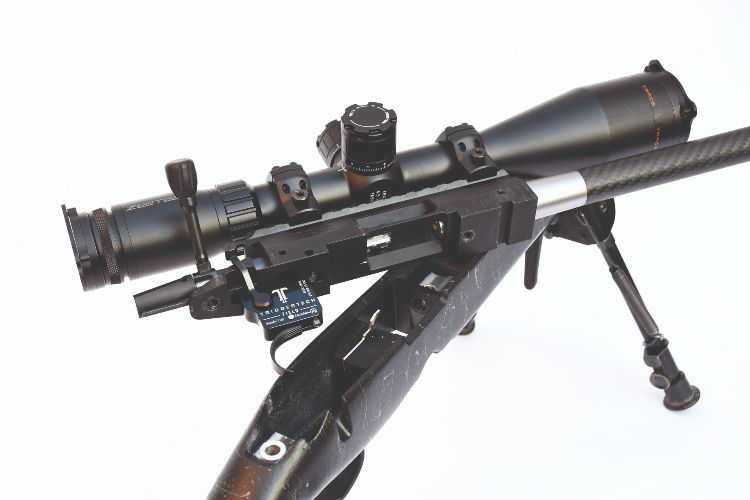 At withdrawal, a manual ejector claw is exposed from a slot on the underside of the bolt, so ejection force is controlled by your handling speed. The proportions of the bolt handle maintain the minimalist approach of the rifle. Its slender arm is not much thicker than a pencil, with a helically fluted teardrop tip for grip. Bolt movement was smooth, without any rattles or jamming. The handle really does look as if it is too thin, but it never gave any problems in use, even with my big hand in gloves, so I was pleased with how Christensen have achieved this balance.
At withdrawal, a manual ejector claw is exposed from a slot on the underside of the bolt, so ejection force is controlled by your handling speed. The proportions of the bolt handle maintain the minimalist approach of the rifle. Its slender arm is not much thicker than a pencil, with a helically fluted teardrop tip for grip. Bolt movement was smooth, without any rattles or jamming. The handle really does look as if it is too thin, but it never gave any problems in use, even with my big hand in gloves, so I was pleased with how Christensen have achieved this balance.
A Remington 700 compatible, single-stage, TriggerTech trigger is fitted. It breaks crisply and is adjustable from 2.5-5lb (approximately 1-2kg), which is ideal for a hunting rifle. The blade shows a moderate curve and longitudinal grooves for grip. The safety catch is part of the trigger mechanism and shows a serrated bar exposed on the right side of the bolt shroud, with forward for fire and rear for safe, without bolt locking. The final control is the magazine release lever in front of the trigger guard.
The magazine design is decades old and very well understood. They clip neatly up into the action without stalling and slide into position easily. Given their boxy shape, that is still to this day a pleasant surprise. The mags load one round at a time from the front, with each bullet taking up pressure on the one before as the internal rotary magazine follower turns against a spring. These mags can be disassembled for maintenance if required, without any tiny components springing free. It’s no surprise that Christensen’s adopted such a well-proven system.
A carbon fibre stock is the obvious choice when light weight is desired. This one shows a black/grey stippled finish. It is totally ambidextrous, with an upright pistol grip and palm swell for assured hold and trigger-reach ergonomics. The flat underside allows the forend to sit stable on bags or a rest, and bipod and sling users are provided with securely fitted studs front and rear.
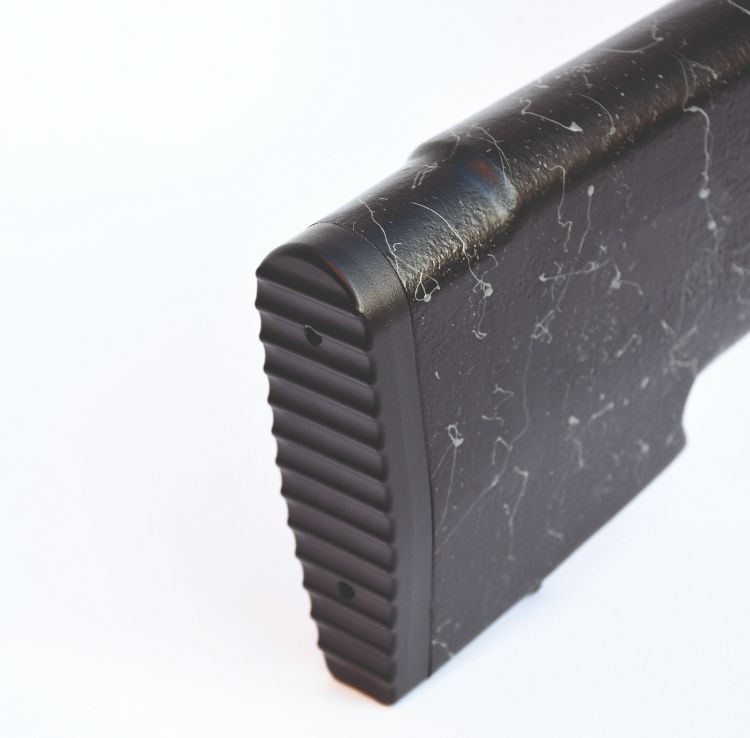 The action is held into the stock by two screws either side of the magazine well. With them removed, the action lifts clear of the stock to reveal a flat bottom that seats into a similarly flat machined inlet within the composite stock. Bedding pillars enable a consistent seat with repeatable action screw torque settings, and although no bedding compound is present, the fit exhibited no stresses when tensioned into place.
The action is held into the stock by two screws either side of the magazine well. With them removed, the action lifts clear of the stock to reveal a flat bottom that seats into a similarly flat machined inlet within the composite stock. Bedding pillars enable a consistent seat with repeatable action screw torque settings, and although no bedding compound is present, the fit exhibited no stresses when tensioned into place.
There is a large steel recoil lug set into the stock, which mates with a groove across the full width of the action’s flat base just ahead of the front action screw. The flat action base has a large contact area with the inlet, which makes it far easier to machine without stress than a multiradiused cylindrical action. I tested this stock with removal and refitting of the action into the stock, with no change in point of impact.
The stiff forend enables the barrel to remain free floated in all conditions. The buttpad has heavy serration – almost like rubber teeth – to grip into your shoulder. There is a butthook on the underside. The flat underside allows your off-gun hand to operate a rest bag or support the rifle’s elevation with a fist. There isn’t any recoil to avoid, but Christensen have maintained intelligent ergonomics with a gradually sloped space under the stock behind the pistol grip’s base for the gun to slide and prevent a defined hard edge bumping into your hand.
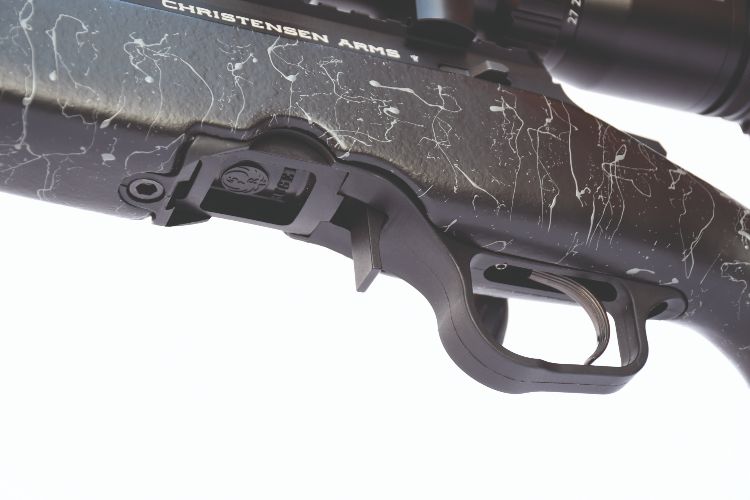 Length of pull is quite short at 350mm/13.25", but spacers can be added. The slim radiused comb is comfortable and suited to personalised additions if you feel you need a harder cheek weld. But with a modestly sized scope this gun was very comfortable from a variety of field shooting positions. The modest palm swell was equally comfortable from either side and presented the trigger blade well within reach in a guard that was spacious enough for gloves.
Length of pull is quite short at 350mm/13.25", but spacers can be added. The slim radiused comb is comfortable and suited to personalised additions if you feel you need a harder cheek weld. But with a modestly sized scope this gun was very comfortable from a variety of field shooting positions. The modest palm swell was equally comfortable from either side and presented the trigger blade well within reach in a guard that was spacious enough for gloves.
Highland Outdoors had supplied a moderator, scope rings and optic for the review, which were fitted without a hitch. The long Picatinny rail atop the action certainly allowed more space for the high-magnification, target-style scope on what I still consider to be a predominantly hunting rifle. I keep mentioning that because although the gun was unquestionably accurate and met Christensen’s own sub-MOA assurances at 50yd, its stunning low weight makes it so easy to carry.
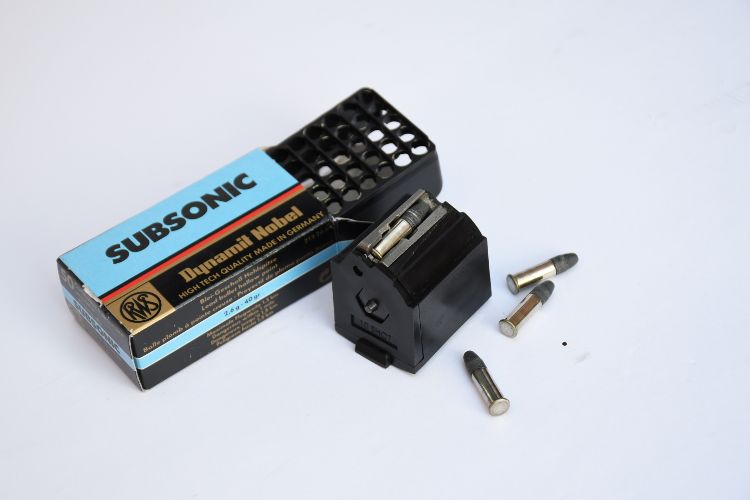 Shooting/ammo testing
Shooting/ammo testing
Shot with a bipod from a bench, performance details are given for the five types of ammunition tested. I rarely ever use high velocity as I like the sound of silence on rimfires, but the Aguila certainly offered speed and energy if required, with clean copper-wash bullets.
| Ammo |
Average
muzzle
velocity
(fps) |
Muzzle
energy
(ft-lb) |
50m
5-shot
group
(mm/inch) |
| RWS Subsonic 40gr |
975 |
84 |
11.5/0.45 |
| Hornady Varmint 40gr |
1035 |
95 |
12.4/0.48 |
| Winchester Hollow Point 40gr |
1064 |
101 |
15.6/0.61 |
| Aguila 30gr |
1566 |
163 |
14.6/0.57 |
| SK Long Range 40gr |
1054 |
99 |
12.2/0.48 |
My normal fare is subsonic lead and, in this rifle, subsonic hunting bullets were my priority. RWS Subsonics are usually the slowest of the breed and correspondingly quiet, and certainly shot the smallest group – but none really disappointed. The Winchester hollow point is very effective on quarry because of its huge frontal cavity, but this is a trade off in ballistic terms where the smaller hollow point RWS or Hornady offerings are a little more aerodynamically efficient when distances increase.
Odd flyers crept in here and there, which I attribute solely to the ammunition and not the rifle. This is where match ammunition can be an advantage, but since the gun met its claims with subsonics, that’s what I continued with.
Although light, the gun maintained a neutral balance point thanks to the light stock offsetting the super-light barrel. The steel Harris bipod and scope add about 70% to the overall weight, so having started at 2,113g I was still left with a rifle that was easy to handle into and out of vehicles, over walls and gates, and rested on whatever was available to make the shot. Compared with my other hunting kit, the rifle was almost negligible in weight and I never even used a sling. It just slotted into my backpack.
Use from quad sticks was made easier by the flat base of the forend, yet it didn’t conflict with a stable hand-wrap grip, and the stock’s minor stippling and texture meant that it wasn’t slippery. There was plenty of space for even gloved hands and fingers/thumbs to avoid barrel contact. Another point to mention was that the forend was stiff enough to be clamped in the tripod sticks without concern over crushing it or affecting point of impact.
So is it a long-range/precision rifle? Well I don’t see why it shouldn’t be if you use a suitable scope, perhaps with elevation-adjustable mounts. It’s comfortable, has a great trigger, is easy to shoot well, and the bolt handle/reload cycle has minimal effect on point of aim when trying to string a series of shots together in a strong wind. Of course, the ultra-light weight is fundamentally at odds with the stability that extra mass gives a rifle on a stable support, but none of the weight savings brought any detrimental precision loss. It’s purely down to the rifle/human interface.
For truly mobile hunting it was a total blessing, and especially when shooting from a vehicle. That light weight and compact length make it easy to manoeuvre in the cab, quieter to slot through a window without a bump, and safer to rest on a door mirror. Recent sub-zero temperatures also illustrate the benefits of handling a non-thermally conductive material that won’t draw all the heat through your gloves or stick to your fingers!
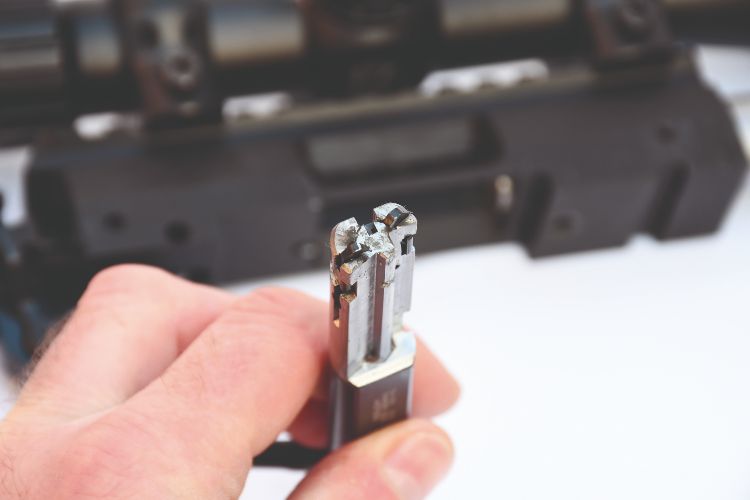 Conclusion
Conclusion
I knew very little about the Ranger before it arrived – not even the price. I was thus able to form my opinions on the basis of the rifle itself, and I must say that it is fantastic and offers some unique benefits. All its functionality is faultless and mechanical reliability and accuracy never take second place to light weight or looks. A few length-of-pull spacers is all I would add.
All the surface finishing is excellent, with no burrs or faults on the stock, inlet or any part of the machined metallic interface. There are four colour options to suit your environment. I even like the mag release, which doesn’t protrude excessively to where it could get snagged or be in the way. Overall this rifle is without doubt a solid and effective working tool.
Tech specs
Calibres: .22 LR on review, also available in .17 HMR and .22 WMR
Barrel length: 457mm/18" carbon fibre wrapped stainless steel
Overall length: 925mm/36.5"
Weight: 2.13kg/4lb 11oz
Muzzle thread: ½"x28
Stock: Composite
Length of pull: 350mm/13.25"
Trigger: Single-stage adjustable, Remington 700 compatible
Safety catch: Two position – forward fire, rear safe, no bolt lock
Magazine: 10+1 Ruger 10-22 rotary magazine (15 and 25 available)
Contact: Highland Outdoors | 01858 880 491